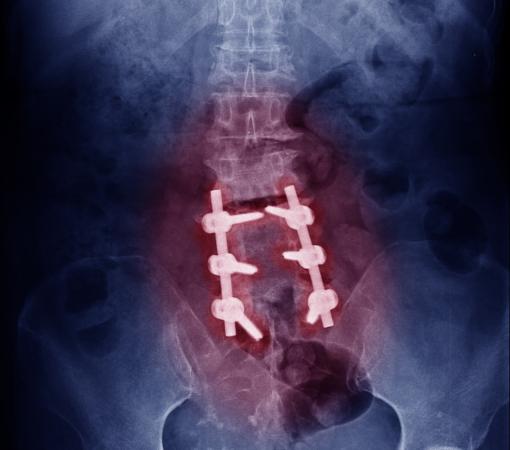Spine Surgeon
Spinal Fusion Surgery in Mumbai
Lumbar Spinal Fusion
Lumbar Spinal Fusion Surgery in Mumbai is a surgical procedure aimed at stabilizing the lumbar spine by fusing two or more vertebrae together. This procedure is typically recommended to address various spinal conditions, including degenerative disc disease, spondylolisthesis, spinal stenosis, or fractures. During lumbar spinal fusion, bone grafts are used to promote bone growth between the vertebrae, facilitating fusion and providing stability to the spine. The surgery may be performed using different approaches, such as posterior fusion, anterior fusion, or lateral fusion, depending on the specific condition and surgical goals. Lumbar spinal fusion is often considered when conservative treatments have failed to provide adequate relief from symptoms or when there is instability or deformity in the lumbar spine.
Posterior Lumbar Interbody Fusion (PLIF)
Posterior Lumbar Interbody Fusion (PLIF) is a surgical procedure used to treat various spinal conditions, including degenerative disc disease and spondylolisthesis. In PLIF, the surgeon accesses the vertebrae through a posterior incision in the patient’s back. The procedure involves meticulous steps to prepare the disc space for fusion. Initially, pre-operative planning is conducted using MRI and CAT scans to determine the appropriate implant size. Subsequently, a surgical incision is made, and the spinal muscles are retracted to expose the vertebral disc. The surgeon then removes the lamina, known as laminectomy, and possibly trims the facet joints to access the nerve roots. After removing the affected disc and surrounding tissue, bone graft, allograft, or a biomechanical spacer implant with bone morphogenetic protein (BMP) is inserted into the disc space to promote fusion between the vertebrae. This implant, often made of bone, metal, or other materials, is complemented by additional instrumentation such as rods or screws to stabilize the spine.
Transforaminal lumbar interbody fusion (TLIF)
Transforaminal Lumbar Interbody Fusion (TLIF) is a surgical procedure emerging as a popular alternative to traditional fusion techniques for lumbar spine conditions. Unlike PLIF, TLIF involves accessing the spine through a midline incision in the patient’s back, approaching from the side of the spinal canal. This approach minimizes muscle dissection and reduces nerve manipulation, making it less traumatic and safer for the nerves. TLIF allows for minimal access and endoscopic techniques, further enhancing its appeal.
Similar to PLIF and ALIF, TLIF involves removing disc material and replacing it with bone graft, along with cages, screws, or rods as needed, to promote fusion and enhance spinal stability. Advanced cage technologies, including bone, titanium, polymer, and bioresorbable materials, are utilized to optimize fusion outcomes.
Oblique lumbar interbody fusion (OLIF)
Oblique Lumbar Interbody Fusion (OLIF) is a surgical procedure that accesses the lumbar spine through an oblique approach from the patient’s side, typically through a small incision in the flank area. Unlike traditional approaches, OLIF avoids major muscle dissection and disruption, minimizing postoperative pain and promoting faster recovery. Specialized retractors and imaging techniques, such as fluoroscopy, enable precise visualization and placement of surgical instruments. During OLIF, damaged disc material is removed and replaced with bone graft, supported by a cage made of materials like titanium or polymer. OLIF offers several advantages, including reduced risk of nerve injury, shorter hospital stays, and quicker return to normal activities. However, it may be limited to accessing only certain levels of the spine and may not be suitable for all patients or conditions.
Anterior lumbar interbody fusion (ALIF)
Anterior Lumbar Interbody Fusion (ALIF) is a surgical procedure akin to PLIF, but conducted from the front (anterior) of the body, usually through an incision in the lower abdominal area or on the side. This approach may involve cutting through and subsequently repairing the muscles in the lower abdomen. At our practice, we offer a mini-open ALIF approach that preserves muscle integrity and allows access to the front of the spine through a small incision, maintaining abdominal muscle strength and function, commonly utilized for fusing the L5-S1 disc space.
Once the incision is made and the vertebrae accessed, and after retracting the abdominal muscles and blood vessels, the disc material is removed. Subsequently, the surgeon inserts bone graft and anterior interbody cages, rods, or screws as necessary to stabilize the spine and promote fusion.
Extreme lateral interbody fusion (XLIF)
eXtreme Lateral Interbody Fusion (XLIF) is an innovative minimally invasive approach to anterior spine surgery, offering advantages over traditional methods by avoiding abdominal incisions and minimizing disruption to back muscles. With XLIF, the disc space is accessed through a small incision on the patient’s side, typically a couple of inches in length, often accompanied by a smaller incision nearby. Specialized retractors and fluoroscopy technology provide real-time x-ray guidance, ensuring precision and safety during the procedure. Monitoring equipment helps assess the proximity of surgical instruments to spinal nerves.
During XLIF, the damaged disc material is removed and replaced with bone graft, supported by a cage made of materials like bone, titanium, carbon fiber, or polymer. This technique often results in shorter hospital stays and reduced postoperative discomfort compared to traditional approaches. However, XLIF has limitations, as it can only be used for vertebrae accessible from the side of the body, and typically allows access to only one or two spinal levels.
Experience premier spine care in Mumbai with Synapse Spine, where our team of esteemed spine doctors provides unparalleled expertise and compassionate care. From diagnosis to Spinal Fusion Surgery in Mumbai, we prioritize patient well-being and offer personalized solutions for all spinal conditions. Schedule your appointment today and take the first step towards a healthier spine with Synapse Spine.

